Conference visit: Clojure/conj 2023
Report by Markus Penttilä
1.6.2023 After a couple of years of no live conferences, Clojure/conj was back April 27-28, held at the Clojure capital itself, Durham, North Carolina. I have been to a couple of EuroClojures, and of course to the excellent ClojuTRE conferences organized by Metosin in Finland but having recently moved to work in our US office in Northern Virginia, now was an excellent opportunity to take the short-ish trip to visit the conj for the first time.
After a couple of years of no live conferences, Clojure/conj was back April 27-28, held at the Clojure capital itself, Durham, North Carolina. I have been to a couple of EuroClojures, and of course to the excellent ClojuTRE conferences organized by Metosin in Finland but having recently moved to work in our US office in Northern Virginia, now was an excellent opportunity to take the short-ish trip to visit the conj for the first time.
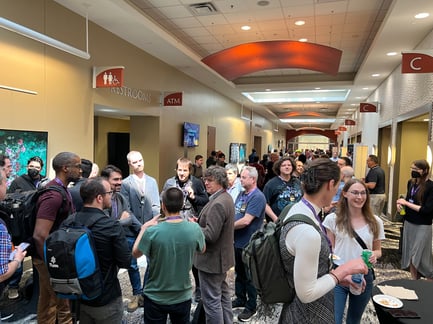 Around 400 in-person attendees, with a surprising number of Europeans (Finland is probably still the per-capita top Clojure country), gathered in the Durham Convention Center for two full days of interesting talks, with parts of the days having dual tracks. It was nice to see how friendly, knowledgeable, and helpful the Clojure community remains.
Around 400 in-person attendees, with a surprising number of Europeans (Finland is probably still the per-capita top Clojure country), gathered in the Durham Convention Center for two full days of interesting talks, with parts of the days having dual tracks. It was nice to see how friendly, knowledgeable, and helpful the Clojure community remains.
The conference started with the shock announcement that Cognitect’s / Nubank’s Datomic database will now be free (though not open source). While I hope this encourages many others to consider using Datomic for their projects, but this was also interesting because we use Datomic as the main database for our North American platform and have been paying for the license. Nubank very graciously offered our just paid yearly fee back and this also led to me having dinner with some very nice people from the Datomic team.
Themes and talks
I left with a feeling that databases and performance were heavily featured, but that might just be because of my personal interest in those topics. Looking back at the talk topics the selection seems pretty balanced. Data science was strongly present, but there were also front-end and architecture-focused talks.
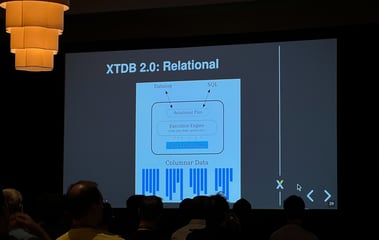 I found João Palharini’s and Filipe Andrade’s “Operating Datomic at Scale” as well as Arne Brasseur’s “BI and Reporting for Datomic” very interesting, as these were very related to some of the things I face at work every day. Jon Pither’s presentation of XTDB 2.0 from JUXT also made me eager to try XTDB somewhere, partly because of the available SQL interface, as those analytics and reporting requirements always come up at some point of the SaaS life.
I found João Palharini’s and Filipe Andrade’s “Operating Datomic at Scale” as well as Arne Brasseur’s “BI and Reporting for Datomic” very interesting, as these were very related to some of the things I face at work every day. Jon Pither’s presentation of XTDB 2.0 from JUXT also made me eager to try XTDB somewhere, partly because of the available SQL interface, as those analytics and reporting requirements always come up at some point of the SaaS life.
Chris Nuernberger’s “High Performance Clojure” was an excellent look at some of the ways of improving Clojure performance and his libraries implementing those. One hopes that some of the improvements might find their way to the Clojure core too. His work was also referenced in the more data science focused talks, where every bit of performance is essential when dealing with big or at least awkwardly sized data.
Jeb Beich and Ghadi Shayban shared a story of optimizing Nubank systems’ cost and performance with a new solution to a heavily used index lookup problem. I find this kind of problem solving and optimization work personally one of the most rewarding and fun things to do in software development.
I must also mention Jeaye Wilkerson’s “How to build a Clojure dialect” which was both a funny talk and an interesting look into Clojure compiler internals and what it takes to implement them on a different host platform. Probably the most entertaining talk of the conference was Sam Ritchie’s penultimate “Emmy: Moldable Physics and Lispy Microworlds”, concerning an interactive education tool for physics with great visualizations.
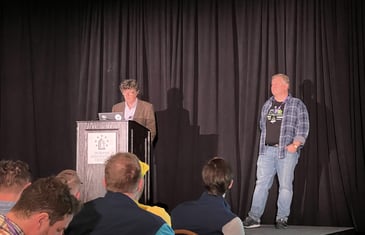 Rich Hickey closed of the conference with his talk “Design in Practice”. This was basically a lesson in how to build your development stories, find the correct problems to solve and arrive to the best solutions to them. A bit heavy topic for the last talk of a long day, but Rich definitely had good points and at least got me immediately thinking about how we could use them in our own planning and development.
Rich Hickey closed of the conference with his talk “Design in Practice”. This was basically a lesson in how to build your development stories, find the correct problems to solve and arrive to the best solutions to them. A bit heavy topic for the last talk of a long day, but Rich definitely had good points and at least got me immediately thinking about how we could use them in our own planning and development.
Other things
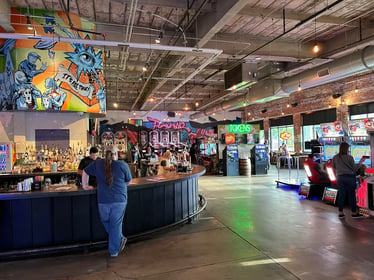 Official evening program consisted of a board game night on Thursday (which I did not make it into) and a bar with an arcade on Friday (nice place otherwise, but too loud for discussion everywhere). One free drink was provided, so this was definitely not the extravaganza of yesteryears. That is fine though, having any kind of conference in the U.S. is crazy expensive.
Official evening program consisted of a board game night on Thursday (which I did not make it into) and a bar with an arcade on Friday (nice place otherwise, but too loud for discussion everywhere). One free drink was provided, so this was definitely not the extravaganza of yesteryears. That is fine though, having any kind of conference in the U.S. is crazy expensive.
JUXT, Metosin and Flexiana being sponsors here was kind of surprising, but it was nice to see familiar faces. In some sense I think it would be nice companies from North or South America filling the sponsor slots on this side of the pond. It is also quite clear that almost all of the participants were on the older side. We should somehow find more young programmers to be the next generation in the community.
![]()
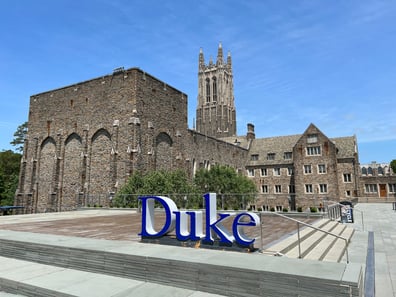 Durham was a nice place to visit, with a compact walkable downtown with lots of restaurants and the interesting American Tobacco Historic District. I spent the Saturday in the city before my flight to Finland in the evening and visited the gardens and campus of Duke University, which I would recommend as well.
Durham was a nice place to visit, with a compact walkable downtown with lots of restaurants and the interesting American Tobacco Historic District. I spent the Saturday in the city before my flight to Finland in the evening and visited the gardens and campus of Duke University, which I would recommend as well.
Overall, an excellent trip, and fun to be back in a live event. Let us hope we get a conference back in Finland soon as well.
Writer Markus Penttilä is the Head of Architecture in Cloudpermit and has been a key player in creating both Lupapiste in Finland and Cloudpermit in North America.
Kiinnostaisiko sinua kuulla lisää?
Tutustu myös kehitystiimiläisten mietteisiin ja avoimiin työpaikkoihimme. Etsimme tiimiin jatkuvasti uusia mukavia ja taitavia ohjelmistokehittäjiä!


